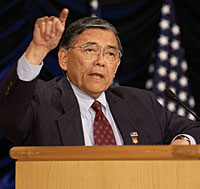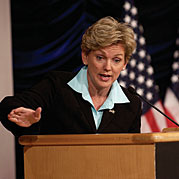A Perfect Storm
"We are in the midst of what is a perfect storm" regarding energy, said Sen. Ken Salazar (D-Colo.). Congress continues to consider energy legislation. At the same time, "We have a problem with respect to energy supplies."We have not done enough to tackle the energy issue, stated Salazar. "America today is held hostage to sources of oil from countries that are not friendly to the interests of the United States of America." We need to act now to pass comprehensive energy legislation, he said.

The United States also hasn't been using its energy wisely, he said. "We are wasting 62 percent of all the energy that we consume. We've been oblivious that we can do more to stretch our energy supply."
However, "we can get to energy independence in America," said Salazar. But it's going to take leadership by the president and Congress.
He explained that there are four components to the energy legislation being deliberated. One is energy efficiency. This includes energy and water conservation measures for federal buildings, the continuation of energy savings performance contracts for federal buildings, support for weatherization, appliance rebates, and energy efficiency standards for refrigerators and other products.
The second component is renewable energy. This includes utilizing renewable energy resources such as biomass, ethanol, solar, and wind, he said.
The third component is new technology. This includes incentives for such things as coal gasification and zero-emissions coal.
The fourth component is development. This includes developing oil resources here in the United States through offshore oil drilling and drilling in the Arctic National Wildlife Refuge (ANWR).
With technological breakthroughs, Salazar noted that we could also extract more from our current resources. For example, if we could develop a workable way to convert oil shale, we could produce as much as 1 trillion barrels of oil, he said.
There is a menu of options out there but "we need to get our shoulder behind it. We need to come together in a united way," Salazar said.

Discussing The Urgency
A panel discussion on "The Urgency of Energy Efficiency" was moderated by Branko Terzic, global regulatory policy leader in the energy resources group of Deloitte & Touche. Panelists were Charles Cicchetti, an economist at the University of Southern California, and Gil Quinones, senior vice president of energy and telecommunications for the New York City Economic Development Corp. and chair of the New York City energy policy task force.Cicchetti pointed out that the current energy situation in the United States has some similarities to the early 1970s. We're almost at the same level of oil prices, adjusted for inflation. However, energy consumption now is half of what it was back then.
"We've learned how to do things better and smarter," he said. With higher oil prices, "We're learning that being energy efficient is the way to go."
Having more than half of our oil produced outside the United States is a major concern, said Cicchetti. The good news, though, is that the economy is strong so that businesses can make investments in efficiency and consumers can buy efficient products.

Cicchetti agreed that government should lead the way in investing in efficiency.
Moving Our Energy Resources
Secretary of Transportation Norman Mineta talked about what his department is doing to transport energy resources. He explained the operations of the Pipeline and Hazardous Materials Safety Administration, which sets performance standards for "integrity management."Like the rest of the Bush administration, Mineta is very high on the prospects for hydrogen fuel cells and the development of a hydrogen economy. "With the hydrogen fuel cell, we are on the verge of another technological revolution on the order of the silicon chip," he said.

A State's Initiatives
Jennifer Granholm, governor of Michigan, described her state's energy efficiency initiatives, for which she received an Energy Leadership Award at the Forum. Granholm said she recognized that state government has to be a leader, so she directed that the state must reduce energy use by 10 percent in all state buildings by 2008, and must also reduce the grid-based purchase of energy by 20 percent by 2015.Granholm noted that the city of Grand Rapids has the highest number of green buildings per capita - 11 percent of all Leadership in Energy and Environmental Design (LEED) buildings are in Grand Rapids.
She added that she would like all state buildings to be LEED certified.
A new policy for powering down buildings when state offices are not in use reduced energy consumption by 16 percent, the governor said, for $400,000 in savings annually. "It's a win-win-win to be energy efficient," said Granholm.
Manufacturing And Efficiency
John Engler, president of the National Association of Manufacturers (NAM), remarked that "industry is consuming something like one-third of America's energy." So manufacturers have a big stake in what's going on with energy policy and energy efficiency.Manufacturers help to save energy by "retooling plants, rewriting processes, and inventing whole new technology-based industries to squeeze more output from every unit of energy invested in the manufacturing of goods," said Engler.
By becoming more and more efficient, "we can improve financial results and compete to win in the fierce global marketplace and at the same time do better for the environment," he said.
Engler said that high energy prices put a lot of stress on manufacturers and that threatens jobs. "If we don't get an energy bill, it puts 2 million jobs at risk."
Energy legislation needs to address energy supply and affordability as well as efficiency, he said. And we need that legislation now. "We've got to end all the uncertainty that's out there on Main Street."
Publication date: 07/04/2005


Report Abusive Comment